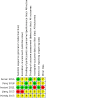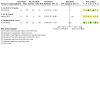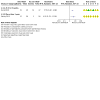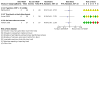Anti-vascular endothelial growth factor for neovascular glaucoma
- PMID: 37010901
- PMCID: PMC10069372
- DOI: 10.1002/14651858.CD007920.pub4
Anti-vascular endothelial growth factor for neovascular glaucoma
Abstract
Background: Neovascular glaucoma (NVG) is a potentially blinding, secondary glaucoma. It is caused by the formation of abnormal new blood vessels, which prevent normal drainage of aqueous from the anterior segment of the eye. Anti-vascular endothelial growth factor (anti-VEGF) medications are specific inhibitors of the primary mediators of neovascularization. Studies have reported the effectiveness of anti-VEGF medications for the control of intraocular pressure (IOP) in NVG.
Objectives: To assess the effectiveness of intraocular anti-VEGF medications, alone or with one or more types of conventional therapy, compared with no anti-VEGF medications for the treatment of NVG.
Search methods: We searched CENTRAL (which contains the Cochrane Eyes and Vision Trials Register); MEDLINE; Embase; PubMed; and LILACS to 19 October 2021; metaRegister of Controlled Trials to 19 October 2021; and two additional trial registers to 19 October 2021. We did not use any date or language restrictions in the electronic search for trials.
Selection criteria: We included randomized controlled trials (RCTs) of people treated with anti-VEGF medications for NVG.
Data collection and analysis: Two review authors independently assessed the search results for trials, extracted data, and assessed risk of bias, and the certainty of the evidence. We resolved discrepancies through discussion.
Main results: We included five RCTs (356 eyes of 353 participants). Each trial was conducted in a different country: two in China, and one each in Brazil, Egypt, and Japan. All five RCTs included both men and women; the mean age of participants was 55 years or older. Two RCTs compared intravitreal bevacizumab combined with Ahmed valve implantation and panretinal photocoagulation (PRP) with Ahmed valve implantation and PRP alone. One RCT randomized participants to receive an injection of either intravitreal aflibercept or placebo at the first visit, followed by non-randomized treatment according to clinical findings after one week. The remaining two RCTs randomized participants to PRP with and without ranibizumab, one of which had insufficient details for further analysis. We assessed the RCTs to have an unclear risk of bias for most domains due to insufficient information to permit judgment. Four RCTs examined achieving control of IOP, three of which reported our time points of interest. Only one RCT reported our critical time point at one month; it found that the anti-VEGF group had a 1.3-fold higher chance of achieving control of IOP at one month (RR 1.32, 95% 1.10 to 1.59; 93 participants) than the non-anti-VEGF group (low certainty of evidence). For other time points, one RCT found a three-fold greater achievement in control of IOP in the anti-VEGF group when compared with the non-anti-VEGF group at one year (RR 3.00; 95% CI:1.35 to 6.68; 40 participants). However, another RCT found an inconclusive result at the time period ranging from 1.5 years to three years (RR 1.08; 95% CI: 0.67 to 1.75; 40 participants). All five RCTs examined mean IOP, but at different time points. Very-low-certainty evidence showed that anti-VEGFs were effective in reducing mean IOP by 6.37 mmHg (95% CI: -10.09 to -2.65; 3 RCTs; 173 participants) at four to six weeks when compared with no anti-VEGFs. Anti-VEGFs may reduce mean IOP at three months (MD -4.25; 95% CI -12.05 to 3.54; 2 studies; 75 participants), six months (MD -5.93; 95% CI -18.13 to 6.26; 2 studies; 75 participants), one year (MD -5.36; 95% CI -18.50 to 7.77; 2 studies; 75 participants), and more than one year (MD -7.05; 95% CI -16.61 to 2.51; 2 studies; 75 participants) when compared with no anti-VEGFs, but such effects remain uncertain. Two RCTs reported the proportion of participants who achieved an improvement in visual acuity with specified time points. Participants receiving anti-VEGFs had a 2.6 times (95% CI 1.60 to 4.08; 1 study; 93 participants) higher chance of improving visual acuity when compared with those not receiving anti-VEGFs at one month (very low certainty of evidence). Likewise, another RCT found a similar result at 18 months (RR 4.00, 95% CI 1.33 to 12.05; 1 study; 40 participants). Two RCTs reported the outcome, complete regression of new iris vessels, at our time points of interest. Low-certainty evidence showed that anti-VEGFs had a nearly three times higher chance of complete regression of new iris vessels when compared with no anti-VEGFs (RR 2.63, 95% CI 1.65 to 4.18; 1 study; 93 participants). A similar finding was observed at more than one year in another RCT (RR 3.20, 95% CI 1.45 to 7.05; 1 study; 40 participants). Regarding adverse events, there was no evidence that the risks of hypotony and tractional retinal detachment were different between the two groups (RR 0.67; 95% CI: 0.12 to 3.57 and RR 0.33; 95% CI: 0.01 to 7.72, respectively; 1 study; 40 participants). No RCTs reported incidents of endophthalmitis, vitreous hemorrhage, no light perception, and serious adverse events. Evidence for the adverse events of anti-VEGFs was low due to limitations in the study design due to insufficient information to permit judgments and imprecision of results due to the small sample size. No trial reported the proportion of participants with relief of pain and resolution of redness at any time point.
Authors' conclusions: Anti-VEGFs as an adjunct to conventional treatment could help reduce IOP in NVG in the short term (four to six weeks), but there is no evidence that this is likely in the longer term. Currently available evidence regarding the short- and long-term effectiveness and safety of anti-VEGFs in achieving control of IOP, visual acuity, and complete regression of new iris vessels in NVG is insufficient. More research is needed to investigate the effect of these medications compared with, or in addition to, conventional surgical or medical treatment in achieving these outcomes in NVG.
Trial registration: ClinicalTrials.gov NCT02396316 NCT02914626.
Copyright © 2023 The Cochrane Collaboration. Published by John Wiley & Sons, Ltd.
Conflict of interest statement
Thanitsara Rittiphairoj: none known Gloria Roberti: none known Manuele Michelessi: Allergan (talk at educational course), Santen (travel accomodation for attending eductional course)
Figures







Update of
-
Anti-vascular endothelial growth factor for neovascular glaucoma.Cochrane Database Syst Rev. 2020 Feb 6;2(2):CD007920. doi: 10.1002/14651858.CD007920.pub3. Cochrane Database Syst Rev. 2020. Update in: Cochrane Database Syst Rev. 2023 Apr 3;4:CD007920. doi: 10.1002/14651858.CD007920.pub4. PMID: 32027392 Free PMC article. Updated. Review.
References
References to studies included in this review
Arcieri 2015 {published data only}
-
- ACTRN12607000577415. Efficacy and safety of intravitreal avastin in eyes with neovascular glaucoma undergoing Ahmed glaucoma valve implantation. www.anzctr.org.au/Trial/Registration/TrialReview.aspx?id=82392 (first received 4 November 2007).
-
- Arcieri ES, Paula JS, Jorge R, Barella KA, Arcieri RS, Secches DJ, et al. Efficacy and safety of intravitreal bevacizumab in eyes with neovascular glaucoma undergoing Ahmed glaucoma valve implantation: 2-year follow-up. Acta Ophthalmologica 2015;93(1):e1-6. - PubMed
-
- Arcieri ES, Secches DJL, Paula JS, Barella KA, Arcieri RS, Jorge R, et al. Efficacy and safety of intravitreal bevacizumab in eyes with neovascular glaucoma undergoing Ahmed glaucoma valve implantation - preliminary report. Investigative Ophthalmology & Visual Science 2010;51:627 (Poster A471).
Deng 2018 {published data only}
-
- Deng Y, Zhang J-S. Anti-VEGF medicine with PRP for neovascular glaucoma. International Eye Science 2018;18(10):1855-8.
Inatani 2021 {published data only}
-
- Higashide T, Inatani M, Matsushita K, Ueki M, Kubota T, Iwamoto Y, et al. Efficacy and safety of intravitreal aflibercept injection (IAI) in neovascular glaucoma (NVG): the VEGA study. Investigative Ophthalmology & Visual Science 2019;60:2398.
-
- NCT02396316. Japanese phase 3 study of aflibercept in neovascular glaucoma patients. clinicaltrials.gov/ct2/show/NCT02396316 (first received 24 March 2015).
Jiang 2015 {published data only}
-
- Jiang WP, Lu SS, Jin Y. Clinical research of retinal laser photocoagulation and ranibizumab on the treatment of neovascular glaucoma. International Eye Science 2015;15(10):1763-5.
Mahdy 2013 {published data only}
-
- Mahdy RA, Nada WM, Fawzy KM, Alnashar HY, Almosalamy SM. Efficacy of intravitreal bevacizumab with panretinal photocoagulation followed by Ahmed valve implantation in neovascular glaucoma. Journal of Glaucoma 2013;22(9):768-72. - PubMed
References to studies excluded from this review
Bai 2021 {published data only}
ChiCTR‐IPR‐15006695 {published data only}
-
- ChiCTR-IPR-15006695. Adjunctive with intravitreal injection of ranibizumab before Ahmed glaucoma valve implantation in the treatment of neovascular glaucoma: a prospective randomized controlled study. trialsearch.who.int/Trial2.aspx?TrialID=ChiCTR-IPR-15006695 (first received 05 July 2015).
ChiCTR‐OPN‐16008147 {published data only}
-
- ChiCTR-OPN-16008147. Intravitreal ranibizumab injection combined trabeculectomy versus Ahmed valve surgery in the treatment of neovascular glaucoma: assessment of efficacy and complications. trialsearch.who.int/Trial2.aspx?TrialID=ChiCTR-OPN-16008147 (first received 24 March 2016). - PMC - PubMed
Dorrans 2020 {published data only}
-
- Dorrans B, Llano A. Bevacizumab. Practical Diabetes 2020;37(2):70-1.
Elwehidy 2019 {published data only}
EUCTR2007‐000585‐21‐IE {published data only}
-
- EUCTR2007-000585-21-IE. Randomised controlled trial of intravitreal Bevacizumab vs. conventional treatment for rubeotic glaucoma. trialsearch.who.int/Trial2.aspx?TrialID=EUCTR2007-000585-21-IE (first received 02 June 2007).
EUCTR2008‐005464‐14‐DE {published data only}
-
- EUCTR2008-005464-14-DE. An open label, prospective, monocenter, prove of concept study to evaluate the short- and long-term effects of 0.5 mg intraocular Ranibizumab (Lucentis) injections as adjuvant for patients with rubeosis and neovascular glaucoma. trialsearch.who.int/Default.aspx (first received 14 November 2008).
Gou 2020 {published data only}
-
- Gou JY, Wang HQ, Wang XH, Zhang L, Zhu XF. Conbercept combined with PRP in the treatment of early nevoascular glaucoma secondary to central retinal vein occlusion. International Eye Science 2020;20(9):1617-20.
IRCT2016042527595N1 {published data only}
-
- IRCT2016042527595N1. Effects of bevacizumab in Ahmed glaucoma valve surgery. trialsearch.who.int/Trial2.aspx?TrialID=IRCT2016042527595N1 (first received 3 August 2016).
Jiang 2019 {published data only}
-
- Jiang H, Li JC, Huang YL. Ranibizumab combined with vitrectomy for DR with neovascular glaucoma. International Eye Science 2019;19(6):988-91.
JPRN‐UMIN000000895 {published data only}
-
- JPRN-UMIN000000895. The study for surgical outcome of trabeculectomy for neovascular glaucomatous patients who received an additional bevacizumab treatment after the surgery. trialsearch.who.int/Trial2.aspx?TrialID=JPRN-UMIN000000895 (first received 19 November 2007).
JPRN‐UMIN000001136 {published data only}
-
- JPRN-UMIN000001136. The study for surgical outcome of trabeculectomy for neovascular glaucomatous patients who received bevacizumab treatment before the surgery. trialsearch.who.int/Trial2.aspx?TrialID=JPRN-UMIN000001136 (first received 5 May 2008).
JPRN‐UMIN000003854 {published data only}
-
- JPRN-UMIN000003854. Proteomic analyses of regulating factors of neovascular ocular inflammation and retinal edema. trialsearch.who.int/Trial2.aspx?TrialID=JPRN-UMIN000003854 (first received 1 July 2010).
JPRN‐UMIN000013974 {published data only}
-
- JPRN-UMIN000013974. The effect of intra-vitreal injection of bevacizumab for vascular endothelial factor-related intraocular diseases. trialsearch.who.int/Trial2.aspx?TrialID=JPRN-UMIN000013974 (first received 19 May 2014).
Liu 2020 {published data only}
-
- Liu Z. Clinical observation of new EX-PRESS glaucoma drainage combined with Ranibizumab for neovascular glaucoma. International Eye Science 2020;20(5):847-51.
Muhsen 2019 {published data only}
NCT02914626 {unpublished data only}
-
- NCT02914626. Intravitreal ranibizumab (Lucentis®) for neovascular glaucoma - a randomized controlled study. clinicaltrials.gov/ct2/show/NCT02914626 (first received 26 September 2016).
NCT04970251 {published data only}
-
- NCT04970251. Aflibercept as adjunctive treatment for filtration surgery in neovascular glaucoma. ClinicalTrials.gov/show/NCT04970251 (first received 21 July 2021).
RBR‐9wkw73j {published data only}
-
- RBR-9wkw73j. Clinical study of the use of bevacizumab in glaucoma surgery. trialsearch.who.int/Trial2.aspx?TrialID=RBR-9wkw73j (first received 30 May 2021).
Song 2019 {published data only}
-
- Song RX. Effect of conbercept combined with trabeculectomy on aqueous humor VEGF and SDF-1 levels for patients with neovascular glaucoma. Chinese Journal of Pharmaceutical Biotechnology 2019;26(6):521-4.
Sun 2019 {published data only}
TCTR20160826002 {published data only}
-
- TCTR20160826002. Risk factors associated hyphema after intravitreal injection of bevacizumab before trabeculectomy for neovascular glaucoma. trialsearch.who.int/Trial2.aspx?TrialID=TCTR20160826002 (first received 26 August 2016).
Wu 2020 {published data only}
-
- Wu XY, Li WN, Xu JF. Effect of modified Ahmed drainage valve implantation combined with conbercept in the treatment of neovascular glaucoma. International Eye Science 2020;20(1):143-6.
Yang 2020 {published data only}
-
- Yang L, Li SY, Liu HY, Xu Q, Liu YL, Fan W, et al. Conbercept combined with 25G vitrectomy and trabeculectomy for NVG secondary to PDR and VH. International Eye Science 2020;20(8):1399-1404.
Yuryevich 2019 {published data only}
-
- Yuryevich MV, Kubyshkin AV, Ivashchenko AS, Samarin SA, Ogbonna G, Fomochkin II. Effectiveness of anti-VEGF agents in patients with retinal vein occlusion. Medical News of North Caucasus 2019;14(3):481-5.
Zarei 2021 {published data only}
-
- Zarei R, Ghasempour M, Fakhraie G, Eslami Y, Mohammadi M, Hamzeh N, et al. Ahmed glaucoma valve implantation with and without subconjunctival bevacizumab in refractory glaucoma. International Ophthalmology 2021;41(5):1593-1603. - PubMed
Zhao 2020 {published data only}
-
- Zhao Y, Yu M, Dai Y, Zhang R, Li JQ, Tang YH. Effect on vision and complications of conbercept combined with EX-PRESS glaucoma drainage device implantation for patients with neovascular glaucoma. International Eye Science 2020;20(10):1809-13.
Additional references
Aiello 1994
-
- Aiello LP, Avery RL, Arrigg PG, Keyt BA, Jampel HD, Shah ST, et al. Vascular endothelial growth factor in ocular fluid of patients with diabetic retinopathy and other retinal disorders. New England Journal of Medicine 1994;331(22):1480-7. - PubMed
Andreoli 2007
-
- Andreoli CM, Miller JW. Anti-vascular endothelial growth factor therapy for ocular neovascular disease. Current Opinion in Ophthalmology 2007;18(6):502-8. [PMID: ] - PubMed
Andrés‐Guerrero 2017
Avery 2006
-
- Avery RL. Regression of retinal and iris neovascularization after intravitreal bevacizumab (Avastin) treatment. Retina 2006;26(3):352-4. - PubMed
Blankenship 1988
-
- Blankenship GW. A clinical comparison of central and peripheral argon laser panretinal photocoagulation for proliferative diabetic retinopathy. Ophthalmology 1988;95(2):170-7. - PubMed
Covidence [Computer program]
-
- Covidence. Melbourne, Australia: Veritas Health Innovation, accessed 1 May 2019. Available at covidence.org.
Deeks 2011
-
- Deeks JJ, Higgins JPT, Altman DG, editor(s). Chapter 9: Analysing data and undertaking meta-analyses. In: Higgins JPT, Green S, editor(s). Cochrane Handbook for Systematic Reviews of Interventions Version 5.1.0 (updated March 2011). The Cochrane Collaboration, 2011. Available from training.cochrane.org/handbook/archive/v5.1.
Delgado 2003
-
- Delgado MF, Dickens CJ, Iwach AG, Novack GD, Nychka DS, Wong PC, et al. Long-term results of noncontact neodymium:yttrium-aluminum-garnet cyclophotocoagulation in neovascular glaucoma. Ophthalmology 2003;110(5):895-9. - PubMed
Doft 1984
-
- Doft BH, Blankenship G. Retinopathy risk factor regression after laser panretinal photocoagulation for proliferative diabetic retinopathy. Ophthalmology 1984;91(12):1453-7. - PubMed
Dong 2018
Ehlers 2008
-
- Ehlers JP, Spirn MJ, Lam A, Sivalingam A, Samuel MA, Tasman W. Combination intravitreal bevacizumab/panretinal photocoagulation versus panretinal photocoagulation alone in the treatment of neovascular glaucoma. Retina 2008;28(5):696-702. - PubMed
Gandhi 2008
-
- Gandhi JS. Use of antivascular agents for neovascular glaucoma: benefits beyond pressure? Clinical and Experimental Ophthalmology 2008;36(1):102-3. - PubMed
GRADEpro GDT [Computer program]
-
- GRADEpro GDT. Hamilton (ON): McMaster University (developed by Evidence prime), accessed 2 January 2019. Available at gradepro.org.
Grover 2009
-
- Grover S, Gupta S, Sharma R, Brar VS, Chalam KV. Intracameral bevacizumab effectively reduces aqueous vascular endothelial growth factor concentrations in neovascular glaucoma. British Journal of Ophthalmology 2009;93(2):273-4. - PubMed
Gupta 2009
-
- Gupta V, Jha R, Rao A, Kong G, Sihota R. The effect of different doses of intracameral bevacizumab on surgical outcomes of trabeculectomy for neovascular glaucoma. European Journal of Ophthalmology 2009;19(3):435–41. - PubMed
Ha 2017
Hayreh 2003
-
- Hayreh SS. Management of central retinal vein occlusion. Ophthalmologica 2003;217(3):167-88. - PubMed
Higgins 2011a
-
- Higgins JPT, Altman DG, Sterne JAC, editor(s). Chapter 8: Assessing risk of bias in included studies. In: Higgins JPT, Green S, editor(s). Cochrane Handbook for Systematic Reviews of Interventions Version 5.1.0 (updated March 2011). The Cochrane Collaboration, 2011. Available from training.cochrane.org/handbook/archive/v5.1.
Higgins 2011b
-
- Higgins JPT, Deeks JJ, Altman DG, editor(s). Chapter 16: Special topics in statistics. In: Higgins JPT, Green S, editor(s), Cochrane Handbook for Systematic Reviews of Interventions Version 5.1.0 (updated March 2011). The Cochrane Collaboration, 2011. Available from training.cochrane.org/handbook/archive/v5.1.
Higgins 2022
-
- Holger JS, Julian PTH, Gunn EV, Paul G, Elie AA, Nicole S, et al, Cochrane GRADEing Methods Group (formerly Applicability and Recommendations Methods Group) and the Cochrane Statistical Methods Group. Chapter 14: Completing ‘Summary of findings’ tables and grading the certainty of the evidence. In: Higgins JPT, Thomas J, Chandler J, Cumpston M, Li T, Page MJ, et al (editors). Cochrane Handbook for Systematic Reviews of Interventions version 6.3 (updated February 2022). Cochrane, 2022. Available from www.training.cochrane.org/handbook.
Hwang 2015
-
- Hwang HB, Han JW, Yim HB, Lee NY. Beneficial effects of adjuvant intravitreal bevacizumab injection on outcomes of Ahmed glaucoma valve implantation in patients with neovascular glaucoma: systematic literature review. Journal of Ocular Pharmacology and Therapeutics 2015;31(4):198-203. [PMID: ] - PubMed
Hwang 2021
Iliev 2006
-
- Iliev ME, Domig D, Wolf-Schnurrbursch U, Wolf S, Sarra GM. Intravitreal bevacizumab (Avastin) in the treatment of neovascular glaucoma. American Journal of Ophthalmology 2006;142(6):1054-6. - PubMed
Inatani 2020
-
- Inatani M, Higashide T, Matsushita K, Nagasato D, Takagi H, Ueki M, et al . Efficacy and safety of intravitreal aflibercept injection in Japanese patients with neovascular glaucoma: outcomes from the VENERA study. Advances in Therapy 2021;38(2):1106-15. [DOI: 10.1007/s12325-020-01580-y] - DOI - PMC - PubMed
Kang 2014
-
- Kang JY, Nam KY, Lee SJ, Lee SU. The effect of intravitreal bevacizumab injection before Ahmed valve implantation in patients with neovascular glaucoma. International Ophthalmology 2014;34(4):793-9. - PubMed
Kiuchi 2006
-
- Kiuchi Y, Nakae K, Saito Y, Ito S, Ito N. Pars plana vitrectomy and panretinal photocoagulation combined with trabeculectomy for successful treatment of neovascular glaucoma. Graefe's Archive for Clinical and Experimental Ophthalmology 2006;244(12):1627-32. - PubMed
Kovacic 2004
-
- Kovacic Z, Ivanisevic M, Rogosic V, Plavec A, Karelovic D. Cyclocryocoagulation in treatment of neovascular glaucoma [Ciklokriokoagulacija u lijecenju neovaskularnoga glaukoma]. Lijecnicki Vjesnik 2004;126(9-10):240-2. - PubMed
Minckler 2006
Noor 2017
Olmos 2016
Pagenstecher 1871
-
- Pagenstecher H. Contribution to the teachings of hemorrhagic glaucoma [Beitrage zur lehre vom hämorrhagischen glaucom]. Graefe's Archive for Clinical and Experimental Ophthalmology 1871;17:98-130.
Review Manager 2014 [Computer program]
-
- Review Manager 5 (RevMan 5). Version 5.3. Copenhagen: Nordic Cochrane Centre, The Cochrane Collaboration, 2014.
Rodrigues 2016
Solomon 2019
Sone 1996
-
- Sone H, Okuda Y, Kawakami Y, Hanatani M, Suzuki H, Kozawa T, et al. Vascular endothelial growth factor level in aqueous humor of diabetic patients with rubeotic glaucoma is markedly elevated. Diabetes Care 1996;19(11):1306-7. - PubMed
Tripathi 1998
-
- Tripathi RC, Li J, Tripathi BJ, Chalam KV, Adamis AP. Increased level of vascular endothelial growth factor in aqueous humor of patients with neovascular glaucoma. Ophthalmology 1998;105(2):232-7. - PubMed
Tsai 2008
-
- Tsai JC, Wand M. Chapter 213: Neovascular glaucoma. In: Alm A, Grosskreutz C, editors(s). Albert and Jakobiec's Principles and Practice of Ophthalmology. 3rd edition. Vol. 2. Canada: Saunders Elsevier, 2008:2689.
Wakabayashi 2008
-
- Wakabayashi T, Oshima Y, Sakaguchi H, Ikuno Y, Miki A, Gomi F, et al. Intravitreal bevacizumab to treat iris neovascularization and neovascular glaucoma secondary to ischemic retinal diseases in 41 consecutive cases. Ophthalmology 2008;115(9):1571-80. - PubMed
Wilkins 2005
Wittstrom 2012
-
- Wittstrom E, Holmberg H, Hvarfner C, Andreasson S. Clinical and electrophysiologic outcome in patients with neovascular glaucoma treated with and without bevacizumab. European Journal of Ophthalmology 2012;22(4):563-74. - PubMed
Wormald 2001
Yalvac 2007
-
- Yalvac IS, Eksioglu U, Satana B, Duman S. Long-term results of Ahmed glaucoma valve and Molteno implant in neovascular glaucoma. Eye 2007;21(1):65-70. - PubMed
Yazdani 2007
-
- Yazdani S, Hendi K, Pakravan M. Intravitreal bevacizumab (Avastin) injection for neovascular glaucoma. Journal of Glaucoma 2007;16(5):437-9. - PubMed
Yazdani 2009
-
- Yazdani S, Hendi K, Pakravan M, Mahdavi M, Yaseri M. Intravitreal bevacizumab for neovascular glaucoma: a randomized controlled trial. Journal of Glaucoma 2009;18(8):632-7. - PubMed
Zhou 2016
-
- Zhou M, Xu X, Zhang X, Sun X. Clinical outcomes of Ahmed glaucoma valve implantation with or without intravitreal bevacizumab pretreatment for neovascular glaucoma: a systematic review and meta-analysis. Journal of Glaucoma 2016;25(7):551-7. [PMID: ] - PubMed
References to other published versions of this review
Simha 2009
Simha 2013
Publication types
MeSH terms
Substances
Associated data
Grants and funding
LinkOut - more resources
Full Text Sources
Medical
Research Materials

